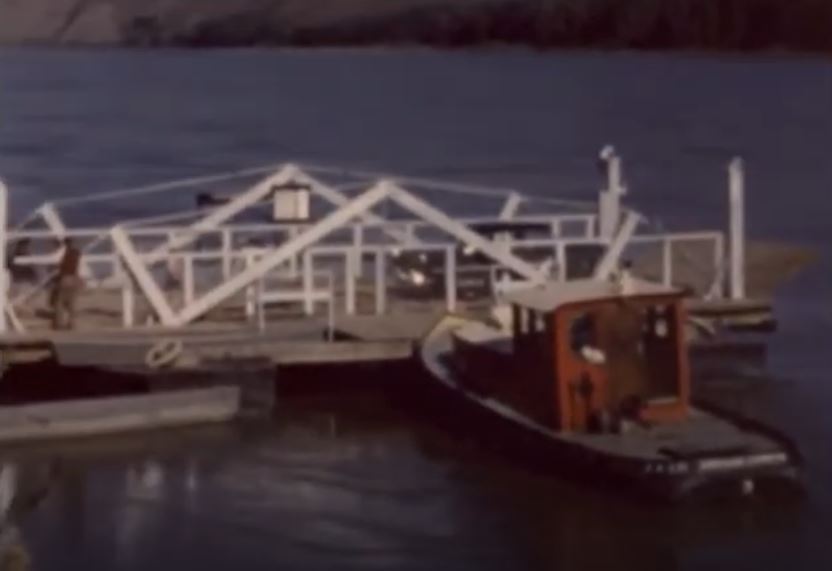Image: A film still showing the Dunvegan ferry (SPRA 253.01.04, Fonds 253: Jerry Stojan family fonds)
Movie Monday highlights videos from the Archives’ film collection. Every week, an archival film will be featured on our YouTube channel and here on our blog. The Movie Monday project is made possible with the generous funding support of Swan City Rotary Club of Grande Prairie.
Today’s film from the Jerry Stojan family fonds (ca. 1954) features several points of interest in the Peace Region, such as the Dunvegan ferry and the view from Twelve Foot Davis’ grave.
The Dunvegan ferry was installed by the provincial government in 1909. It consisted of heavy decking on top of two pontoons, and was connected to a cable that had been strung across the Peace River. It took approximately 30 minutes to cross the river on this ferry. In the 1940’s, the government replaced it with a power ferry. A suspension bridge was finally built in 1960, opening on August 31, and it continues to hold its status as Alberta’s longest vehicle suspension bridge. The power ferry was moved to Tompkins Landing, where it operated from 1961-1987; it is now on display at the La Crete Mennonite Heritage Village.
Like the Dunvegan crossing, Twelve Foot Davis is an icon of the Peace Region. Henry Fuller Davis was born in Vermont in 1820, and in 1849 he headed to California to search for gold. He wasn’t very successful, so he travelled north to the Cariboo gold fields. By the time he got there, most of the prime land had already been staked out. But despite being unable to read or write, he was well aware of the laws regarding the size of claims, and he soon found a way to get his own piece of land. On Willow Creek, two miners had established lucrative claims adjacent to one another and Davis noticed that they were wider than the prescribed 100ft per claim. He approached the commissioner and asked for a legal re-surveying, and indeed, together the two claims measured at 212ft wide. Davis quickly claimed those extra 12 feet, from which he extracted between $20,000 to $30,000 of gold – about half a million dollars in today’s currency. Eventually Davis came to the Peace River area, where he worked as a fur trader; forming alliances with French Canadian, Cree, and Metis traders, he competed against the storied Hudson’s Bay Company. He died in 1900 at Lesser Slave Lake Mission and in 1912 his remains were buried on Grouard Hill as part of a promise once made to him.
This film shows the Stojans crossing on the Dunvegan ferry and enjoying the views from Davis’ grave. There is also footage from a parade along Richmond Avenue, and many scenes of Chuck and Linda growing up on the farm.
Only two more weeks of Movie Monday to go! We have so enjoyed sharing these films with you and will be sorry to see the project come to an end. Be sure to stay tuned for the final two films!
